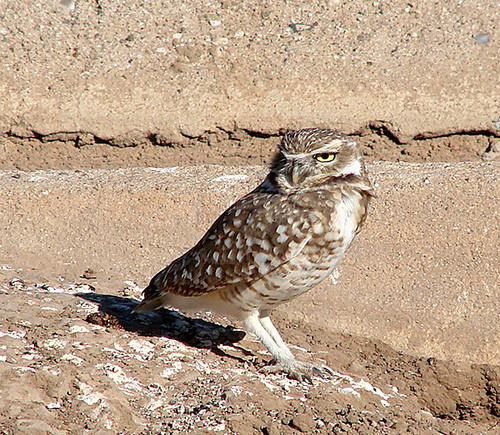The birds weren’t overwhelming, but the birding was great on the Santa Cruz Flats Saturday morning with Michael. We started out with the largest flock of Eurasian Collared-Doves I’d ever seen in Arizona, 260 birds perched on wires in Marana. It was a puzzling sight at first, but the nearly total absence of that species at Red Rock suggested that the survivors of a recent pigeon-shoot there had merely relocated to safer spaces. They are charming and beautiful birds, and you can’t help admiring the “success” of this exotic, but I find the day troubling when I see more of them than Mourning Doves.

Under the influence of my earliest birding companions, I’ve long espoused the most puritanical of views when it comes to introduced species. I can find them fascinating, admirable, dazzlingly beautiful; but they don’t belong here, and I’ve done my share of, ahem, removal. As I grow older and the world grows more complex, though, I’m finding it all less clear-cut.
In a way, we know where Arizona’s Eurasian Collared-Doves came from. The species was introduced to the Caribbean 30 or 40 years ago now, and taking advantage of that same pioneer spirit that had let it spread, apparently on its own, from the Balkans to Iceland in the 1950s, a few ecdos made the short flight to Florida in the 1970s; from there, adhering to what seems to be a pre-programmed predilection for flying northwest, the species has colonized pretty much all of the continental US outside of New England the Mid-Atlantic, and seems to be looking forward to cozy winters in western Canada and Alaska, too.
Collared-doves reached southeast Arizona with this new century, and have since become abundant around feedlots and rural settlements. I suppose we can’t rule out the possibility of secondary introductions–one possible explanation for the local population explosions we’re still seeing–but even so, it’s almost certain that some of the doves in Arizona are the descendants, 30 or 40 generations removed, of the introduced Bahamas birds: and so ultimately, of course, ours are of introduced origin, but the birds of 2008 have come much farther on their own from that tainted source population than did, for example, the state’s first Inca Doves a hundred years earlier, or the White-winged Doves that are now breeding in the midwest.
I’m not suggesting that any exotic species, plant or animal, be left to thrive just because of the antiquity of its introduction or its self-powered success once it got here; gracious, then we’d have, oh, Norway rats and red foxes eating island seabirds or something! There can be no statute of limitations when an introduced organism starts munching on the habitat and its native denizens; no sign yet that Eurasian Collared-Doves are engaged in anything like that, but introductions of any kind are rarely so benign as they’re thought to be at the start.
Just around the corner, at one of their “secret” sites on the Flats, Michael and I found a pair of Burrowing Owls, perched up to absorb the morning sunlight.
Both birds were remarkably active, flying up and down the concrete-lined ditches they call home, chirping and bobbing when a car went past. Too bad they don’t eat collared-doves!
We moved on to Red Rock and its endangered feedlot: the signs are up announcing the zoning hearings, and it won’t be long before that bit of flat desert is houses, too (with preternaturally green lawns, I bet). There were massive flocks of icterids: Red-winged, Yellow-headed, and Brewer’s Blackbirds, Great-tailed Grackles, Brown-headed Cowbirds, and a couple of Western Meadowlarks; but no small doves and virtually no large ones. A glorious Prairie Falcon was perched on a telephone pole, but we didn’t find any other of the “special” raptors of the Flats in the couple of hours we spent out there. But it’s good birding, not necessarily good birds, that makes a good day, and we had lots of the first and enough of the second.


